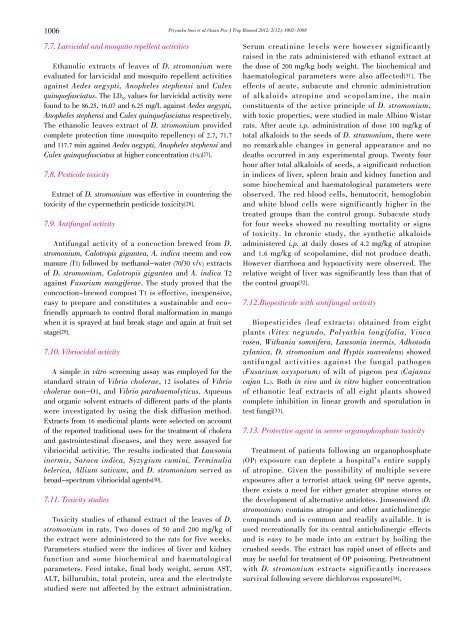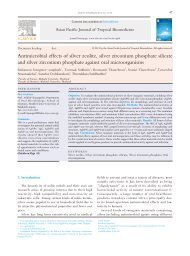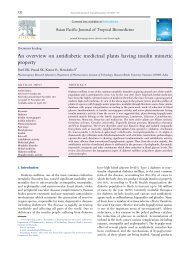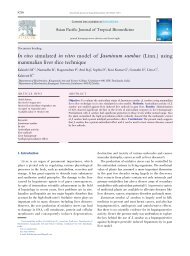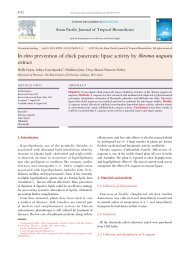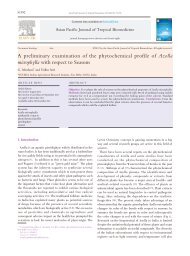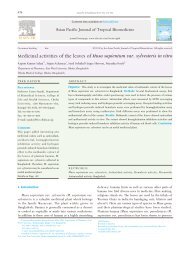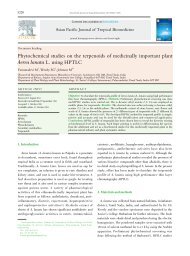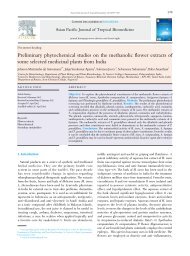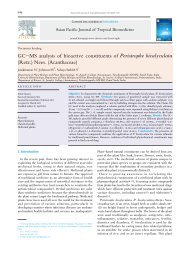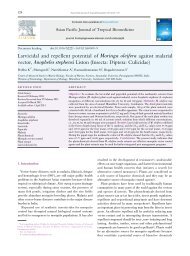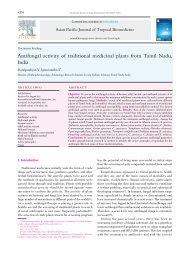Pharmacological properties of Datura stramonium L. as a - Apjtb.com
Pharmacological properties of Datura stramonium L. as a - Apjtb.com
Pharmacological properties of Datura stramonium L. as a - Apjtb.com
Create successful ePaper yourself
Turn your PDF publications into a flip-book with our unique Google optimized e-Paper software.
1006<br />
7.7. Larvicidal and mosquito repellent activities<br />
Ethanolic extracts <strong>of</strong> leaves <strong>of</strong> D. stromonium were<br />
evaluated for larvicidal and mosquito repellent activities<br />
against Aedes aegypti, Anopheles stephensi and Culex<br />
quinquef<strong>as</strong>ciatus. The LD 50 values for larvicidal activity were<br />
found to be 86.25, 16.07 and 6.25 mg/L against Aedes aegypti,<br />
Anopheles stephensi and Culex quinquef<strong>as</strong>ciatus respectively.<br />
The ethanolic leaves extract <strong>of</strong> D. stromonium provided<br />
<strong>com</strong>plete protection time (mosquito repellency) <strong>of</strong> 2.7, 71.7<br />
and 117.7 min against Aedes aegypti, Anopheles stephensi and<br />
Culex quinquef<strong>as</strong>ciatus at higher concentration (1%)[27].<br />
7.8. Pesticide toxicity<br />
Extract <strong>of</strong> D. stromonium w<strong>as</strong> effective in countering the<br />
toxicity <strong>of</strong> the cypermethrin pesticide toxicity[28].<br />
7.9. Antifungal activity<br />
Antifungal activity <strong>of</strong> a concoction brewed from D.<br />
stromonium, Calotropis gigantea, A. indica (neem) and cow<br />
manure (T1) followed by methanol-water (70/30 v/v) extracts<br />
<strong>of</strong> D. stromonium, Calotropis gigantea and A. indica T2<br />
against Fusarium mangiferae. The study proved that the<br />
concoction-brewed <strong>com</strong>post T1 is effective, inexpensive,<br />
e<strong>as</strong>y to prepare and constitutes a sustainable and ec<strong>of</strong>riendly<br />
approach to control floral malformation in mango<br />
when it is sprayed at bud break stage and again at fruit set<br />
stage[29].<br />
7.10. Vibriocidal activity<br />
A simple in vitro screening <strong>as</strong>say w<strong>as</strong> employed for the<br />
standard strain <strong>of</strong> Vibrio cholerae, 12 isolates <strong>of</strong> Vibrio<br />
cholerae non-O1, and Vibrio parahaemolyticus. Aqueous<br />
and organic solvent extracts <strong>of</strong> different parts <strong>of</strong> the plants<br />
were investigated by using the disk diffusion method.<br />
Extracts from 16 medicinal plants were selected on account<br />
<strong>of</strong> the reported traditional uses for the treatment <strong>of</strong> cholera<br />
and g<strong>as</strong>trointestinal dise<strong>as</strong>es, and they were <strong>as</strong>sayed for<br />
vibriocidal activitie. The results indicated that Lawsonia<br />
inermis, Saraca indica, Syzygium cumini, Terminalia<br />
belerica, Allium sativum, and D. stromonium served <strong>as</strong><br />
broad-spectrum vibriocidal agents[30].<br />
7.11. Toxicity studies<br />
Toxicity studies <strong>of</strong> ethanol extract <strong>of</strong> the leaves <strong>of</strong> D.<br />
stromonium in rats. Two doses <strong>of</strong> 50 and 200 mg/kg <strong>of</strong><br />
the extract were administered to the rats for five weeks.<br />
Parameters studied were the indices <strong>of</strong> liver and kidney<br />
function and some biochemical and haematological<br />
parameters. Feed intake, final body weight, serum AST,<br />
ALT, billurubin, total protein, urea and the electrolyte<br />
studied were not affected by the extract administration.<br />
Priyanka Soni et al./Asian Pac J Trop Biomed 2012; 2(12): 1002-1008<br />
Serum creatinine levels were however significantly<br />
raised in the rats administered with ethanol extract at<br />
the dose <strong>of</strong> 200 mg/kg body weight. The biochemical and<br />
haematological parameters were also affected[31]. The<br />
effects <strong>of</strong> acute, subacute and chronic administration<br />
<strong>of</strong> alkaloids atropine and scopolamine, the main<br />
constituents <strong>of</strong> the active principle <strong>of</strong> D. stromonium,<br />
with toxic <strong>properties</strong>, were studied in male Albino Wistar<br />
rats. After acute i.p. administration <strong>of</strong> dose 100 mg/kg <strong>of</strong><br />
total alkaloids to the seeds <strong>of</strong> D. <strong>stramonium</strong>, there were<br />
no remarkable changes in general appearance and no<br />
deaths occurred in any experimental group. Twenty four<br />
hour after total alkaloids <strong>of</strong> seeds, a significant reduction<br />
in indices <strong>of</strong> liver, spleen brain and kidney function and<br />
some biochemical and haematological parameters were<br />
observed. The red blood cells, hematocrit, hemoglobin<br />
and white blood cells were significantly higher in the<br />
treated groups than the control group. Subacute study<br />
for four weeks showed no resulting mortality or signs<br />
<strong>of</strong> toxicity. In chronic study, the synthetic alkaloids<br />
administered i.p. at daily doses <strong>of</strong> 4.2 mg/kg <strong>of</strong> atropine<br />
and 1.6 mg/kg <strong>of</strong> scopolamine, did not produce death.<br />
However diarrhoea and hypoactivity were observed. The<br />
relative weight <strong>of</strong> liver w<strong>as</strong> significantly less than that <strong>of</strong><br />
the control group[32].<br />
7.12.Biopesticide with antifungal activity<br />
Biopesticides (leaf extracts) obtained from eight<br />
plants (Vitex negundo, Polyathia longifolia, Vinca<br />
rosea, Withania somnifera, Lawsonia inermis, Adhotoda<br />
zylanica, D. stromonium and Hyptis suaveolens) showed<br />
antifungal activities against the fungal pathogen<br />
(Fusarium oxysporum) <strong>of</strong> wilt <strong>of</strong> pigeon pea (Cajanus<br />
cajan L.). Both in vivo and in vitro higher concentration<br />
<strong>of</strong> ethanotic leaf extracts <strong>of</strong> all eight plants showed<br />
<strong>com</strong>plete inhibition in linear growth and sporulation in<br />
test fungi[33].<br />
7.13. Protective agent in severe organophosphate toxicity<br />
Treatment <strong>of</strong> patients following an organophosphate<br />
(OP) exposure can deplete a hospital’s entire supply<br />
<strong>of</strong> atropine. Given the possibility <strong>of</strong> multiple severe<br />
exposures after a terrorist attack using OP nerve agents,<br />
there exists a need for either greater atropine stores or<br />
the development <strong>of</strong> alternative antidotes. Jimsonweed (D.<br />
stromonium) contains atropine and other anticholinergic<br />
<strong>com</strong>pounds and is <strong>com</strong>mon and readily available. It is<br />
used recreationally for its central anticholinergic effects<br />
and is e<strong>as</strong>y to be made into an extract by boiling the<br />
crushed seeds. The extract h<strong>as</strong> rapid onset <strong>of</strong> effects and<br />
may be useful for treatment <strong>of</strong> OP poisoning. Pretreatment<br />
with D. stromonium extracts significantly incre<strong>as</strong>es<br />
survival following severe dichlorvos exposure[34].


